Ancient use
The ancient Egyptians wore wigs to shield their shaved, hairless heads from the sun. They also wore the wigs on top of their hair using beeswax and resin to keep the wigs in place. Other ancient cultures, including the Assyrians,Phoenicians, Greeks and Romans, also used wigs as an everyday fashion. Wigs are principally a Western form of dress—in the Far East they have rarely been used except in the traditional theatre of China and Japan. Some East Asian entertainers (Japanese Geisha, Korean Kisaeng) wore wigs (Katsura and gache respectively) as part of their traditional costumes.
Examples of ancient wigs
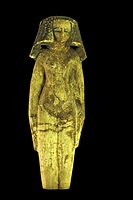
Ushabti of a Concubine; along with the naked body, jewelry underlying the breasts and shaved pubis with visible vulva, the heavy wig give the erotic connotation to the statuette. Painted wood, Middle kingdom.
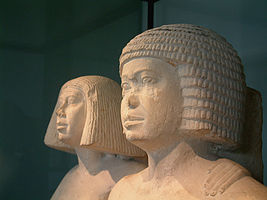
Egyptian couple wearing formal wigs of the 4th of 5th dynasties.
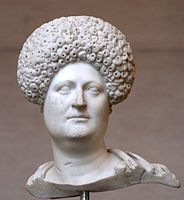
Bust of a Roman woman wearing a "diadem" wig, circa 80 CE.
16th and 17th centuries
After the fall of the Roman Empire, the use of wigs fell into abeyance in the West for a thousand years until they were revived in the 16th century as a means of compensating for hair loss or improving one's personal appearance. They also served a practical purpose: the unhygienic conditions of the time meant that hair attracted head lice, a problem that could be much reduced if natural hair were shaved and replaced with a more easily de-loused artificial hairpiece.Fur hoods were also used in a similar preventative fashion.
Royal patronage was crucial to the revival of the wig. Queen Elizabeth I of England famously wore a red wig, tightly and elaborately curled in a "Roman" style, while among men King Louis XIII of France (1601–1643) started to pioneer wig-wearing in 1624 when he had prematurely begun to bald.This fashion was largely promoted by his son and successor Louis XIV of France (1638–1715) that contributed to its spread in European and European-influenced countries.
Perukes or periwigs for men were introduced into the English-speaking world with other French styles when Charles II was restored to the throne in 1660, following a lengthy exile in France. These wigs were shoulder-length or longer, imitating the long hair that had become fashionable among men since the 1620s. Their use soon became popular in the English court. The London diarist Samuel Pepys recorded the day in 1665 that a barber had shaved his head and that he tried on his new periwig for the first time, but in a year of plague he was uneasy about wearing it:
"3rd September 1665: Up, and put on my coloured silk suit, very fine, and my new periwig, bought a good while since, but darst not wear it because the plague was in Westminster when I bought it. And it is a wonder what will be the fashion after the plague is done as to periwigs, for nobody will dare to buy any haire for fear of the infection? That it had been cut off the heads of people dead of the plague."
Wigs were not without other drawbacks, as Pepys noted on March 27, 1663:
"I did go to the Swan; and there sent for Jervas my old periwig-maker and he did bring me a periwig; but it was full of nits, so as I was troubled to see it (it being his old fault) and did send him to make it clean."
With wigs virtually obligatory garb for men with social rank, wigmakers gained considerable prestige. A wigmakers' guild was established in France in 1665, a development soon copied elsewhere in Europe. Their job was a skilled one as 17th century wigs were extraordinarily elaborate, covering the back and shoulders and flowing down the chest; not surprisingly, they were also extremely heavy and often uncomfortable to wear. Such wigs were expensive to produce. The best examples were made from natural human hair. The hair of horses and goats was often used as a cheaper alternative.
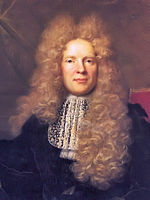
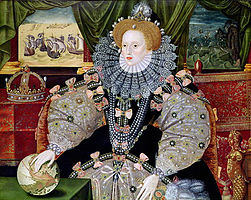

18th century
Five Orders of Periwigs, 1761In the 18th century, men's wigs were powdered in order to give them their distinctive white or off-white color. Contrary to popular belief, women in the 18th century did not wear wigs, but wore a coiffure supplemented by artificial hair or hair from other sources. Women mainly powdered their hair grey, or blue-ish grey, and from the 1770s onwards never bright white like men. Wig powder was made from finely ground starch that was scented with orange flower, lavender, or orris root. Wig powder was occasionally colored violet, blue, pink or yellow, but was most often used as off-white. Powdered wigs (men) and powdered natural hair with supplemental hairpieces (women) became an essential for full dress occasions and continued in use until almost the end of the 18th century. The elaborate form of wigs worn at the coronation of George III in 1761 was lampooned by William Hogarth in his engraving Five Orders of Periwigs. Powdering wigs and extensions was messy and inconvenient, and the development of the naturally white or off-white powderless wig (made of horsehair) for men is no doubt what has made the retention of wigs in everyday court dress a practical possibility. By the 1780s, young men were setting a fashion trend by lightly powdering their natural hair, as women had already done from the 1770s onwards. After 1790, both wigs and powder were reserved for older, more conservative men, and were in use by ladies being presented at court. After 1790 English women seldom powdered their hair. In 1795, the British government levied a tax on hair powder of one guinea per year. This tax effectively caused the demise of both the fashion for wigs and powder. Granville Leveson-Gower, in Paris during the winter of 1796, noted "The word citoyen seemed but very little in use, and hair powder being very common, the appearance of the people was less democratic than in England."
Among women in the French court of Versailles in the mid-to-late 18th century, large, elaborate and often themed wigs (such as the stereotypical "boat poufs") were in vogue for women. These combed-up hair extensions were often very heavy, weighted down with pomades, powders, and other ornamentation. In the late 18th century these coiffures (along with many other indulgences in court life) became symbolic of the decadence of the French nobility, and for that reason quickly became out of fashion from the beginning of the French Revolution in 1789.
During the 18th century, men's wigs became smaller and more formal with several professions adopting them as part of their official costumes. This tradition survives in a few legal systems. They are routinely worn in various countries of the Commonwealth. Until 1823, bishops of the Church of England and Church of Ireland wore ceremonial wigs. The wigs worn by barristers are in the style favoured in the late eighteenth century. Judges' wigs, in everyday use as court dress, are short like barristers' wigs (although in a slightly different style), but for ceremonial occasions judges and also senior barristers (QCs) wear full-bottomed wigs.
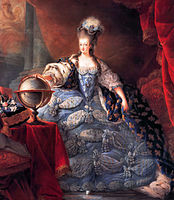
Marie Antoinette wearing the distinctive pouf style coiffure: her own natural hair is extended on the top with an artificial hairpiece.
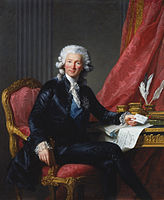
Charles-Alexandre de Calonne by Élisabeth-Louise Vigée-Le Brun (1784), London, Royal Collection. The Vicomte de Calonne is shown wearing a powdered wig; the powder that has fallen from the wig is visible on his shoulders.
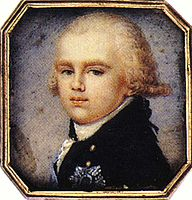
Grand Duke Constantine Pavlovich of Russia as a boy (c. 1795). The latest-born notable person to be portrayed wearing a powdered wig tied in a queue.
19th and 20th centuries
The wearing of wigs as a symbol of social status was largely abandoned in the newly created United States and France by the start of the 19th century. In the United States, only the first five Presidents, from George Washington to James Monroe, wore powdered wigs according to the old-fashioned style of the 18th century.
The latest-born notable person to be portrayed wearing a powdered wig tied in a queue according to this old fashion was Grand Duke Constantine Pavlovich of Russia (born in 1779, portrayed in 1795).
Women's wigs developed in a somewhat different way. They were worn from the 18th century onwards, although at first only surreptitiously. Full wigs in the 19th and early 20th century were not fashionable. They were often worn by old ladies who had lost their hair.[citation needed] In the film Mr. Skeffington (1944), when Bette Davis has to wear a wig after a bout of diphtheria, it is a moment of pathos and a symbol of her frailty.[citation needed]
During the late nineteenth and early twentieth century hairdressers in England and France did a brisk business supplying postiches, or pre-made small wiglets, curls, and false buns to be incorporated into the hairstyle. The use of postiches did not diminish even as women's hair grew shorter in the decade between 1910 and 1920, but they seem to have gone out of fashion during the 1920s.





